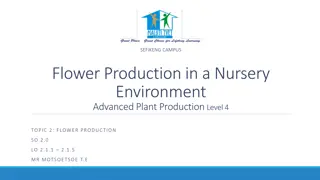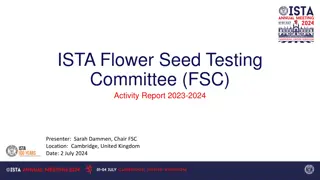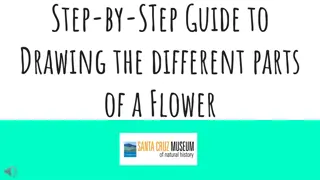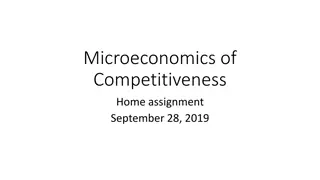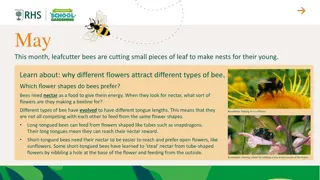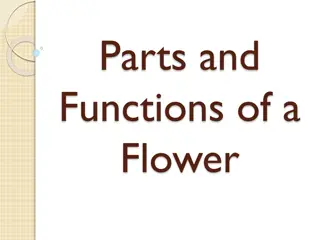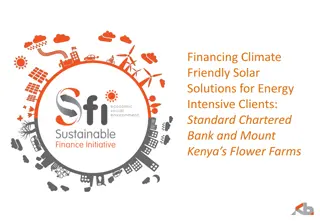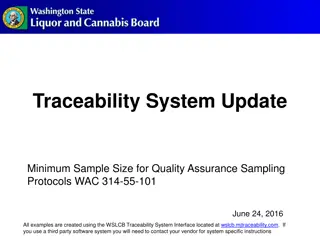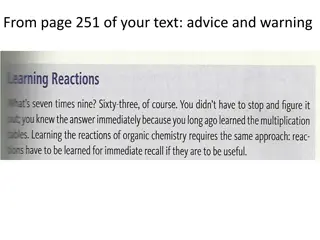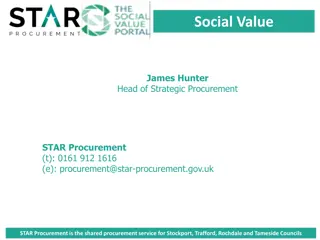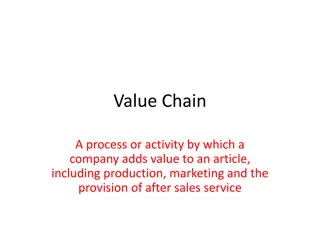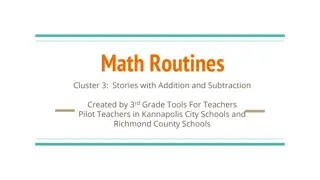Flower Value Addition in Mamillapalli Thriveni
Value addition in flowers is a process that enhances the economic value and consumer appeal of floral commodities through genetic changes, processing, packaging diversification, and postharvest technology adoption. It not only boosts profitability but also serves as a rural development strategy, especially for small-scale floriculture industries. Various areas of value-added floriculture include essential oil extraction, cut flower production, live plants, foliage utilization, and more.
Download Presentation

Please find below an Image/Link to download the presentation.
The content on the website is provided AS IS for your information and personal use only. It may not be sold, licensed, or shared on other websites without obtaining consent from the author. Download presentation by click this link. If you encounter any issues during the download, it is possible that the publisher has removed the file from their server.
E N D
Presentation Transcript
TOPIC:PROSPECTS OF VALUE ADDITION IN FLOWERS MAMILLAPALLI.THRIVENI
PROSPECTS OF VALUE ADDITION IN FLOWERS
INTRODUCTION : Value addition is a process in which for the same volume of a primary product , a high price is realized by means of processing, packing, upgrading the quality or other such methods. Value-added floriculture refers most generally to manufacturing process that increases the value of primary commodities. Value-added floriculture may also refers to increasing the economic value of a commodity through particular production process e.g. Organic produce or through regionally branded products that increase consumer appeal and willingness to pay a premium over similar but differentiated products.
Value-added floriculture is regarded by some, a significant rural development strategy. Value added floriculture is a process of increasing the economic value and consumer appeal of any floral commodity through changes in genetics, processing and packaging diversification with this profitability of a commodity is increased especially small scale floriculture industry. Profit potential is increased when an indistinctive raw commodity is converted into a unique product. The value addition for marketing flowers includes adoption of postharvest technology and improved logistics.
Areas of value-added floriculture Essential oil extraction from flowers. Cut flower production for occasion/flower forcing fresh dried . Live plant/potted plant. Foliage and other parts of plants. Potpourri.
Value added technology: Working with flowers is of course a benefit, but a successful operation requires a great deal of highly specialized knowledge and skills, since the industry is highly technical and scientific. It includes preparation of garlands, bouquets, veni, button-hole, flower baskets, floats, floral wreaths, corsages etc can add value up to 5-10 times from flowers and green foliages . It also includes making of dry flowers and extraction of essential oil or pigments. Even making of value added products is an artistic and creative work much more closely related with women.
No much scientific technology is needed for preparation of these products except some training and economic support. This couldn t be seen in isolation as income generating activity. Infect it is supplemental to existing income. In case of urban or rural women, they can attend to their daily house hold maid or labour. Just some extra time & effort to earn some extra income is needed.
Different Value Added Products: Essential oils Flower bouquets Flower handicrafts Fragrance Flower baskets Phyto chemical Flower wreaths Herbal medicine Flower arrangements Plant pigments Garlands Dye yielding ornaments Potpourri Tinting of flowers Edible flowers Drying of flowers
FLOWER BASKETS
Use of value addition in floriculture Unstable prices for raw commodities. Federal farm policies. Changing consumer preferences. Make more money by cutting out the middle man.
Methods of value addition of flowers Flower Ornaments and Flower arrangement are the important method of value addition. Value addition of flower crops also includes post-harvest and processing technologies. Post-harvest includes: Stage of harvest i. Grading ii. Pulsing iii. Packing iv. Increasing the vase life. v.
Processing includes: i. Drying of flowers ii. Potpourri iii. Tinting of flowers iv. Extraction of essential oil, dyes and drugs.
Objectives of Value Addition: To improve quality. To enhance selling. To gain higher profit. To reduce post harvest loss. Can provide demand for high quality. Use of unsold flowers (unmarketable) i.e. Roses used gulkand. Increase export. To generate employment.
Need for Value Addition: To improve the profitability of farmers . To empower the farmers and other weaker sections of society especially women through gainful employment opportunities and revitalize rural communities. To provide better quality, safe and branded products to the consumers. To emphasize primary and secondary processing. To reduce post harvest losses. Reduction of import & meeting export demands.
Way of increased foreign exchange: Encourage growth of subsidiary industries. Reduce the economic risk of marketing. Increase opportunities for smaller farms and companies through the development of markets. Diversify the economic base of rural communities. Overall, increase farmers financial stability.
Choice for Value Addition : Any attempt for value addition should focus for following parameter for deriving maximum benefit. Unique - The product we develop should be one of its own kinds for which crop and variability indigenous to our country should be exploited. Novelty - The product should be new and unusual like blue or black rose and likewise so that no one can compete. Exportpotential - The product developed should have demand in international market for higher return and appreciation of benefit of global trade.
High value- The product should have high value for low volume for ease of trading and distribution and the extracts from Indian spices and herbal medicinal plants can fulfill this requirement. Availability - Consistent availability of the product in required quantity should be ensured for stable market and faith. Market - Any product that is developed must have market because market is the key for success of any product.
WAYS TO ADD VALUE : Process the raw material. Pre cut, wrap and package. Take a unique approach. Label the product. Distinct product appearance. Increase shelf life. Provide recipes/cookbook. Gift baskets or multi-pack. Build reputation & relationship.
Factor required for value added enterprises : A unique product An enthusiastic promoter of the product I. II. III. The right kind of labeling and packaging IV. Aggressive marketing V. A full time presence on the farm VI. Strong agricultural or livestock knowledge VII. Ability to cater to customers VIII. Assistance from agencies and universities IX. A strong relationships with the local community X. Safe food handling and food safety regulations XI. Product liability insurance
Challenges Varieties as per market preference. Technology for value added products. Knowledge of standards. Synergy in th e plan and approach of agencies at various levels in different functional areas viz. research, extension, finance, quality assurance and certification.


